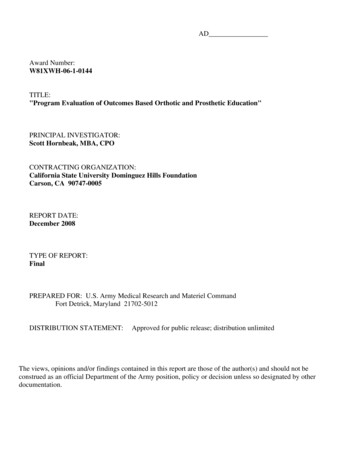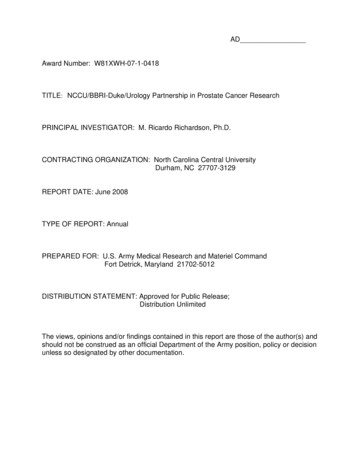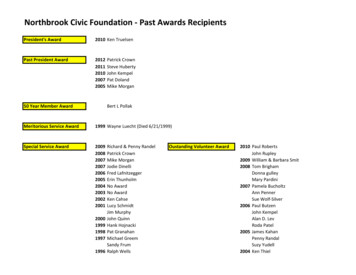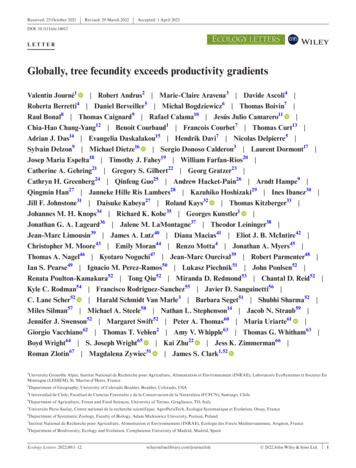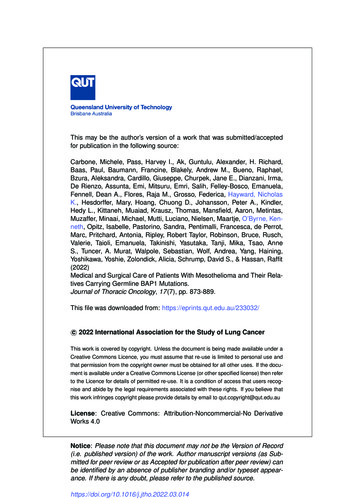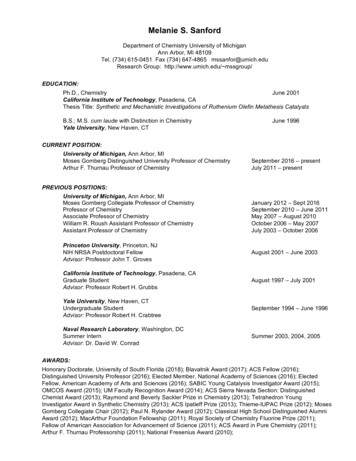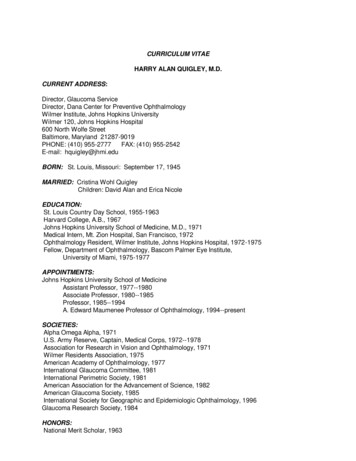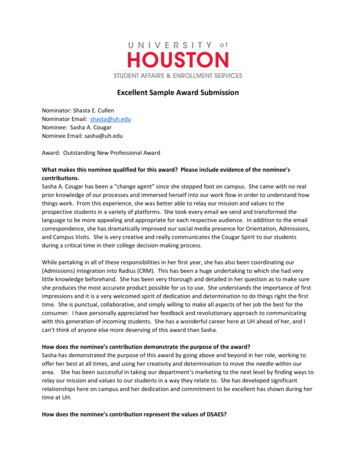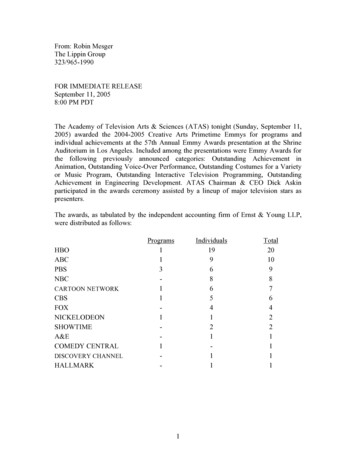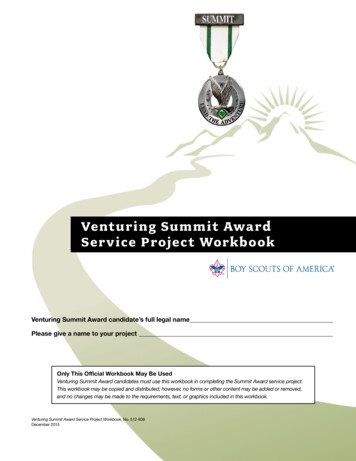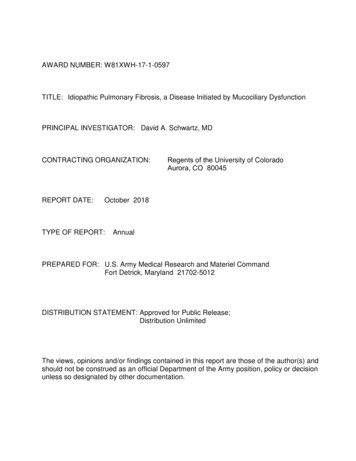
Transcription
AWARD NUMBER: W81XWH-17-1-0597TITLE: Idiopathic Pulmonary Fibrosis, a Disease Initiated by Mucociliary DysfunctionPRINCIPAL INVESTIGATOR: David A. Schwartz, MDCONTRACTING ORGANIZATION:REPORT DATE:Regents of the University of ColoradoAurora, CO 80045October 2018TYPE OF REPORT:AnnualPREPARED FOR: U.S. Army Medical Research and Materiel CommandFort Detrick, Maryland 21702-5012DISTRIBUTION STATEMENT: Approved for Public Release;Distribution UnlimitedThe views, opinions and/or findings contained in this report are those of the author(s) andshould not be construed as an official Department of the Army position, policy or decisionunless so designated by other documentation.
Form ApprovedOMB No. 0704-0188REPORT DOCUMENTATION PAGEPublic reporting burden for this collection of information is estimated to average 1 hour per response, including the time for reviewing instructions, searching existing data sources, gathering and maintaining thedata needed, and completing and reviewing this collection of information. Send comments regarding this burden estimate or any other aspect of this collection of information, including suggestions for reducingthis burden to Department of Defense, Washington Headquarters Services, Directorate for Information Operations and Reports (0704-0188), 1215 Jefferson Davis Highway, Suite 1204, Arlington, VA 222024302. Respondents should be aware that notwithstanding any other provision of law, no person shall be subject to any penalty for failing to comply with a collection of information if it does not display a currentlyvalid OMB control number. PLEASE DO NOT RETURN YOUR FORM TO THE ABOVE ADDRESS.1. REPORT DATE2. REPORT TYPEOctober 20183. DATES COVERED30 Sep 2017 - 29 Sep 2018Annual4. TITLE AND SUBTITLE5a. CONTRACT NUMBERIdiopathic Pulmonary Fibrosis, a Disease Initiated by Mucociliary Dysfunction5b. GRANT NUMBERW81XWH-17-1-05975c. PROGRAM ELEMENT NUMBER6. AUTHOR(S)5d. PROJECT NUMBERDavid Schwartz, MD; Sean Colgan, PhD; Anthony Gerber, MD, PhD; ChristopherEvans, PhD; Ivana Yang, PhD; Tasha Fingerlin, PhD5e. TASK NUMBER5f. WORK UNIT NUMBERE-Mail: david.schwartz@ucdenver.edu7. PERFORMING ORGANIZATION NAME(S) AND ADDRESS(ES)8. PERFORMING ORGANIZATION REPORTNUMBERRegents of the University of Colorado13001 E 17th Place F428Aurora, CO 80045-25719. SPONSORING / MONITORING AGENCY NAME(S) AND ADDRESS(ES)10. SPONSOR/MONITOR’S ACRONYM(S)U.S. Army Medical Research and Materiel CommandFort Detrick, Maryland 21702-501211. SPONSOR/MONITOR’S REPORTNUMBER(S)12. DISTRIBUTION / AVAILABILITY STATEMENTApproved for Public Release; Distribution Unlimited13. SUPPLEMENTARY NOTES14. ABSTRACTThe overarching goal of this Program is to develop the scientific knowledge needed to predict and prevent the progression ofIPF. We postulate that IPF is caused by recurrent injury/repair/regeneration at the bronchoalveolar junction secondary tooverexpression of MUC5B, mucociliary dysfunction, retention of particles, ER stress, and disruption of normal reparative andregenerative mechanisms in the distal lung. During the first year of funding, we have (1) obtained local and DoD approvals forhuman and animal research; (2) enrolled 26 first degree relatives of individuals with IPF and completed all study proceduresfor Project 1; (3) performed ChIP, MNase, and TF binding assays to show that MUC5B promoter region is hyperchippable andthat HIF1 and GCF bind in this region (Project 2); (4) imported and bred new strains of mice (St3gal3, Fut2, Ern2, Ift88, andArl13b) in Projects 3 and 4; (5) developed and assessed the amounts and glycosylation of Muc5b in mouse models atbaseline, and identified changes in polymer size and migration after inflammatory challenge (Project 3); (6) identified 10 weekspost-injury as a key timepoint for increased ciliogenesis in Muc5b Tg mice and began characterization of ciliogenesis in humanlung, and (7) presented findings at two international conferences and published two manuscripts.15. SUBJECT TERMSpreclinical pulmonary fibrosis, biomarkers, airway mucin, mucin 5b polymer, mucociliary dysfunction, transcriptional regulation,lung repair, lung regeneration, ER stress, ciliogenesis16. SECURITY CLASSIFICATION OF:a. REPORTb. ABSTRACT17. LIMITATIONOF ABSTRACTc. THIS PAGEUnclassified19a. NAME OF RESPONSIBLE PERSONUSAMRMC19b. TELEPHONE NUMBER (include areaUnclassifiedUnclassified18. NUMBEROF PAGES36code)UnclassifiedStandard Form 298 (Rev. 8-98)Prescribed by ANSI Std. Z39.18
Table of ContentsPage1. Introduction .12. Keywords .13. Accomplishments . .14. Impact . 215. Changes/Problems. . 226. Products, Inventions, Patent Applications, and/or Licenses. .247. Participants & Other Collaborating Organizations .258. Special Reporting Requirements 339. Appendices 33
Annual Technical Progress ReportReporting period: 9/30/17-9/29/181. IntroductionThe overarching challenge of this Program is to develop the scientific knowledge needed to predictand prevent the progression of Idiopathic Pulmonary Fibrosis (IPF). IPF affects 5 million worldwide,disproportionately affects men, is associated with cigarette smoking and combat-related particulateexposures, increases with age, is inexplicably increasing in prevalence, is a source of morbidity andmortality among military personnel, and is likely underdiagnosed. Patients with IPF are usually diagnosedwhen the fibroproliferative process has caused permanent and extensive lung parenchymal damage. Giventhe irreversible nature of this disease, even approved treatments for IPF only modestly slow progressionand have not been shown to alter the 3-5 year survival following diagnosis. We have found that: 1) a gainof-function MUC5B promoter variant rs35705950 is the strongest risk factor (genetic and otherwise) for thedevelopment of IPF, accounting for at least 30% of the risk of disease; 2) rs35705950 can be used toidentify individuals in the preclinical phase of this life-threatening disease; 3) MUC5B represents a keymolecule to understand the mechanisms that initiate the fibroproliferative process in the bronchoalveolarepithelium; and 4) focusing on MUC5B may provide a unique opportunity to define the early molecularevents that lead to the development of IPF. We propose that a comprehensive, multi-dimensional approachthat focuses on MUC5B transcription in airway epithelia, biological consequences of MUC5Boverproduction that are mediated by airway epithelia and cilia, and biomarkers to predict preclinicalpulmonary fibrosis (PrePF) and identify those at risk of disease progression could conceivably change theapproach in IPF from palliative to preemptive.2. KeywordsPreclinical pulmonary fibrosis, biomarkers, airway mucin, mucin 5b polymer, mucociliary dysfunction,transcriptional regulation, lung repair, lung regeneration, ER stress, ciliogenesis3. Accomplishmentsa. What were the major goals of the project?**pink shading denotes items that were worked on during this project periodSpecific Aim 1: Screen 500 asymptomatic siblings of sporadicIPF cases and perform pulmonary function testing on cases ofpreclinical pulmonary fibrosis (PrePF).TimelineYears 1-3Major Task 1: Recruitment sporadic IPF siblings.Years 1-3Site 1(DavidSchwartz)Sites 2-6Brown,Keith,Loyd,Kass,Wolters,de AdradeSubtask 1: Coordinate with the site PIs to obtain IRB approvalat each site for this study.1-2 mosSchwartz,Mathai““Milestone #1: Secure IRB approval at all sites for subjectrecruitment.1-6 mosSchwartz,Mathai“”Subtask 2: Coordinate with the Investigators to consent IPFsubjects to contact their siblings for study recruitment.1-3 years1Schwartz,Mathai,Schwarz,Lee“”
Subtask 3: Contact siblings of IPF patients to consent them forthe study.1-3 yearsSchwartz,MathaiMajor Task 2: Obtain high-resolution computed tomography(HRCT) scans of chest on recruited siblings from Major Task 1.1-3 yearsSchwartz,Mathai,SchwarzMajor Task 2: Obtain expert radiology reads of the CTimages with thoracic radiologists.1-3 yearsLynch,MathaiMajor Task 3: Obtain pulmonary function testing (PFTs) on allsubjects who have CT scans that are positive for the presence ofPrePF.1-3 yearsMilestone #2: Prepare and submit manuscript on the prevalenceand radiographic features of PrePF in the siblings of patients withsporadic IPF.Specific Aim 2: Develop and validate a biomarker profile thatimproves the detection of preclinical pulmonary fibrosis(PrePF).Schwartz,Mathai,Schwarz,LeeAll investig.2-3 yearsAll investig.TimelineYears 1-3Site 1Sites 2-5(Schwartz) “ “Major Task 1: Develop biomarker panel in PrePF cases from FIPfamily members.- Somapanel, plasma MUC5B, mucin-specific glycans- RNA-seq on PBMC RNA, PBMC telomere length- Genotyping for MUC5B promoter polymorphism1 yearMajor Task 2: Validate biomarker panel in PrePF cases fromsporadic IPF family members.- Somapanel, plasma MUC5B, mucin-specific glycans- RNA-seq on PBMC RNA, PBMC telomere length- Genotyping for MUC5B promoter polymorphism1-3 yearsSchwartz,Mathai,Yang,Fingerlin“”Milestone #3: Prepare manuscript on development of peripheralblood biomarker profile of PrePF.3 yearsAll investig. All investig.Specific Aim 3: Elucidate the determinants of progression inpreclinial pulmonary fibrosis (PrePF).TimelineYears 3-4Site 1Site 2(Schwartz) “ “Major Task 1: Recontact all subjects with Year 1-3 scans positivefor PrePF and perform repeat HRCT 2-3 years after studyenrollment.Years 3-4Major Task 2: Re-contact subjects with Year 1-3 scans positivefor PrePF and perform repeat PFTs 2-3 years after initial studyenrollment.Years 3-4““““Major Task 3: Recontact all subjects with initial Year 1-3 scanspositive for PrePF and perform repeat peripheral blood draw.Years 3-4““““Major Task 4: Measure the same peripheral biomarkers in thecollected samples as described under Aim 2.Years 3-4Schwartz,Mathai, Yang2Schwartz,Mathai,Schwarz,Lee““
Major Task 5: Analyze differences in peripheral blood biomarkersbetween subjects with PrePF and those without PrePF.Milestone #4: Prepare manuscript on development of peripheralblood biomarker profile of progressive PrePF.Target EnrollmentYear 4All investig.Year 4All investig. All investig.Projected Quarterly EnrollmentYear t Enrollment5555510405Target EnrollmentQ15555555555101080120Year 3Q2Q3UCODVAMCNJHUPMCUCSFUABVanderbiltTarget ear 2Q2Q355555510101010551010260310Year 4Q2Q3Q45551010510360Q4---500500500-
Project 2Site 1: University of Colorado, National Jewish Medical Center12700 E 19th Ave, RC2 – 10025Aurora, CO 80045Initiating PI: Drs. Sean Colgan and Anthony GerberSpecific Aim 1: Elucidate the molecular regulation of theMUC5B gene promoter relative to identified major IPFassociated polymorphism.Specific Aim 1: Development of a High-Throughput ImagerTimelineSite 1(Initiating PI)MonthsSubtask 1: Elucidate transcription factor binding analysisParticipating teams: Colgan and Gerber labs will oversee molecular analysis of ChIPassays and luciferase reporter constructs1-4ColganGerberSubtask 2: Generate MUC5B SNP cell line Colgan, Gerber & Seibold will work together to oversee thegeneration of these lines using CRISPR-Cas9 methods4-8ColganSeiboldGerberSubtask 3: Direct transcription factor loss of function approach in cell linesand primary cells. Molecular approach to knocking down individual transcriptionfactors (Gerber and Colgan) Work in primary cells (Seibold and Colgan) Test transcription factor principles in mice with Evans8-12ColganGerberEvansSeiboldSubtask 1: Use ChIP-loop to determine 3 dimensionalchromatin architecture and enhancer interactions within theMUC5B locus Determine cooperative binding of FOXA2 using ChIP-lookanalysis12-24GerberSubtask 2: Analyze dynamic MU5B enhancer looping andimpact of the promoter variant and pro-fibrotic stimuli. Analyze dynamic looping in association with MUC5B Define the contribution of HIF to molecular regulation ofMUC5B.24-30Gerber,ColganEvansMilestone #1: Co-author manuscript on MUC5B regulation.Specific Aim 2: : Determine integrated transcriptional control ofMUC5B expression in response to pro-fibrotic signalsMilestone #1: Co-author manuscript on molecular regulation ofMUC5B and variantColganGerber, EvansSpecific Aim 3: Elucidate the impact of MUC5B variant on airwaywound healing and proteostasisSubtask 1: Elucidate the influence of MUC5B variant on UPR andepithelial proteostasis utilizing airway cell lines.430-40ColganGerber,EvansSite 2(PartneringPI)
Subtask 2: Define the impact of MUC5B rs35705950 variant onepithelial wound healing and barrier function. Studies in cell lines, mouse models of airway fibrosis.Milestone #2: Co-author manuscript on functional impact ofMUC5B variant in airway epithelia.540-48Colgan,GerberEvansColgan,Gerber, Evans
Site 1:University of Colorado (UCo)12700 East 19th Ave, MS 8611Aurora, CO 80045PI: Dr. Christopher EvansProject 3Site 2:University of Alabama at Birmingham1918 University BlvdBirmingham, AL 35294Co-I: Dr. Steven RoweSpecific Aim 1: Demonstrate that MUC5B/Muc5b overproduction byclub cells and type II cells in distal airways promotes dysfunctionalMCC.Major Task 1: Regulatory approval, establishment of mouse colonies.Subtask 1: Regulatory approval of animal research.Milestone #1: Secure IACUC approval at University of Colorado.Milestone #2: Secure ACURO approval.Subtask 2: Animal breeding for experiments.Milestone #1: Import C57BL/6J mice and ROSAmT/mG strains.Milestone #2: Breed C57BL/6J, Scgb1a1-Muc5b Tg, SFTPC-Muc5b Tg,Scgb1a1CreER/ ;Muc5blox/lox; SftpcCreERT2/ ;Muc5blox/lox;TimelineYears 1-4Site 1Months0-30-3Evans0-3All UCoinvestig.3-18ROSAmT/mG mice.Major Task 2: Demonstrate that Muc5b overproduction in murine PF impairsMCC and mucus transport in vivo and in vitro.Milestone #1: Acute and Chronic MCC in Scgb1a1-Muc5b Tg,SFTPC-Muc5b Tg, Scgb1a1-Muc5bΔ/Δ; SftpcCreERT2/ ;Muc5bΔ/ΔMilestone #2: Mucus transport in primary lung epithelial cultures fromScgb1a1-Muc5b Tg, SFTPC-Muc5b Tg, Scgb1a1-Muc5bΔ/Δ;Months0-120-12SftpcCreERT2/ ;Muc5bΔ/Δ, & human cells IPF, rs35705950 ‘T’Milestone #3: Statistical analysis of DataMajor Task 3: Demonstrate that aberrantly glycosylated MUC5B/Muc5baccumulates in the airways in PF.Milestone #1: Quantify MUC5B/Muc5b, SCGB1A1/Scgb1a1, SPC,MAL II, and UEA I labels human and mouse lung tissues by histology.Milestone #2: Demonstrate colocalization of secretedMUC5B/Muc5b with glycan markersMilestone #3: Statistical analysis of DataMilestone #4: Manuscript submission and publication: Aim 1 DataMajor Task 4: Determine whether an MCC defect in PrePF and IPF areassociated with rs35705950 genotype.Milestone #1: Secure IRB approval at UAB for subject recruitment.Milestone #2: Perform rs35705950 genotypingMilestone #3: Perform Tc99 MCC assaysMilestone #4: Statistical analysis of Tc99 MCC dataMilestone #5: Manuscript submission and publication: Human study.612-18Symmes,Hara(7-10mice/grp) (4-6humanculture/grp)All investig.Months6-186-1812-189-18Symmes,Hara (710mice/grp) (812humantissues/grp)All investig.Months0-33-423-423-4842-48Rowe, deAndradeHaraRowe, deAndradeAll investig.
Specific Aim 2: Determine whether Muc5b-dependent pro-fibroticeffects in mice are induced by aberrant mucin biosynthesis andproteostasis programs in club cells and T2 cellsMajor Task 1: Characterize the dependence of glycosylation of Muc5b ongene expression levels and cellular source.Milestone #1: Demonstrate colocalization of intracellularMUC5B/Muc5b with glycan markers and cell specific markers.Milestone #2: Identify changes in polymer size and migration byWestern.TimelineYears 2-3Months13-2413-24Milestone #3: Statistical analysis of DataMajor Task 2: Determine the effects of Muc5b levels and localization onmucin biosynthetic enzyme expression in bleomycin-induced fibrosis.MonthsMilestone #1: Isolated and purify cells from fluorescent-tagged mice20-26Milestone #2: Analyze St3Gal1- St3Gal6, St6Gal1- St6Gal2, Fut1Fut11, and Agr2 transcript and protein levels.24-27Milestone #3: Statistical analysis of DataMajor Task 3: Determine the effects of Muc5b levels and localization onproteostasis dysfunction in bleomycin-induced fibrosis.Milestone #1: Identify significant UPR/ER stress markers Atf6,Ern1(IRE-1α), Ern2 (IRE-1β), Ddit3 (CHOP), Hspa5 (Grp78/BiP),Eif2ak3 (PERK), and Xbp1/spliced Xbp1 in Muc5b-overexpressingmice.Milestone #2: Confirm protein levels & localization of markersabove.Milestone #3: Statistical analysis of DataMajor Task 4: Effects of mucin biosynthesis and proteostasisregulators on Muc5b protein synthesis and pro-fibrotic mediatorproduction.Milestone #1: Test ER Stress activation in MUC5B-expressing lungepithelial cell lines (A549, NCI-H292, and LC-2/ad) and NHBE’s.Milestone #2: Test significance of ER Stress activation usinglentiviral overexpression and shRNA-mediated knockdown.Milestone #3: Statistical analysis of DataMilestone #4: Manuscript submission and publication: Aim 1 DataSpecific Aim 3: Determine the critical mechanisms required forMUC5B/Muc5b to promote pulmonary fibrosis.Major Task 1: In vivo studies.Milestone #1: Breed St3gal3, Fut2, Agr2, and Ern2 (IRE-1β) knockoutmice for experiments. Obtain other candidates as needed.Milestone #2: Test effects genetic deficiency in in vivo models above onMuc5b levels, localization, and glycosylation and on epithelialproteostasis, ER stress, and fibrosis.716-2727-30Symmes,Hara (7-10mice/grp) (812humantissues/grp)All investig.Symmes,Hara (7-10mice/grp) (812humantissues/grp)All investig.Months24-2727-3030-32Symmes,Hara (7-10mice/grp) (812humantissues/grp)All investig.Months24-3630-3624-3627-36TimelineYears 2-4Months13-4424-36Symmes,Hara (7-10mice/grp) (812humantissues/grp)All investig.Symmes,HaraSymmes,Hara(7-10
Milestone #3: Test effects of pharmacologic and enzyme interventions inin vivo models above on Muc5b levels, localization, and glycosylation andon epithelial proteostasis, ER stress, and fibrosis.Major Task 2: In vitro studies.Milestone #1: Test effects genetic deficiency in models above on mucustransport, and epithelial expression of pro-fibrotic mediators in vitro.mice/grp)33-44Months38-41Milestone #2: Test effects of pharmacologic and enzyme interventions on40-46mucus transport, and expression of pro-fibrotic mediators in vitro.Major Task 2: Analysis and dissemination of Research.MonthsMilestone #1: Statistical analysis of Data13-48Milestone #2: Manuscript submission and publication: Aim 1 Data28-48Projected Quarterly EnrollmentYear 1Year 2Q1Q2Q3Q4Q1Q2Q3Q4UAB3Target Enrollment3UABTarget Enrollment33331215Q169Year 3Q2Q3Q432733033633333All investig.3Q11821Year 4Q2Q3Q433934245345Symmes,Hara(7-10mice/grp) (4-6humanculture/grp)24Project 4Site 1: University of Colorado Anschutz Medical Campus (AMC) 12700 East19th Avenue, 8611, Aurora, CO 80045 Initiating PI: Dr. Ivana YangAim 1: Determine the effect of Muc5b concentration on expressionof cilium-associated genes in distal airway stem cell populationsfollowing injury in mice.Major Task 1: Regulatory approval and animal breeding.Subtask 1: Regulatory approval of animal research.Milestone #1: Secure IACUC approval at University of Colorado.Milestone #2: Secure ACURO approval.Subtask 2: Animal breeding for experiments.Milestone #2: Breed enough Muc5b-/-, Scgb1a1-Muc5bTg and SPCMuc5bTg for experiments to commence.Major Task 2: Markers of ciliogenesis (Arl13b and Foxj1), Muc5b andMmp7 will be co-localized with basal cell markers (Krt5, Krt14, and p63)and β-catenin following injury.TimelineYears 1-2Site 1Year 1month 0months 0-3Dr. Yangmonth 3-9Ms. DavidsonYears 1-2Milestone #1: Treat Muc5b-/-, Scgb1a1-Muc5bTg and SPC-Muc5bTg micewith bleomycin and H1N1 virus. Collect tissue for IF staining.months 3-12Milestone #2: Perform IF staining, take images, and performqualitative analysis of the image data.months 12-18Ms. Davidson, Dr.Evans, Dr. YangFellow TBN, Ms.Davidson, Dr.Yang, Dr. BrodyMilestone #3: Perform quantitative analysis of the image data and statisticalFellow TBN, Drs.months 18-24 Eickelberg, Yanganalysis.8
Major Task 3: Identify changes in cilium gene expression in isolatedDASC populations at multiple timepoints following injury.Milestone #1: Treat Muc5b-/-, Scgb1a1-Muc5bTg and SPC-Muc5bTgmice with bleomycin and H1N1 virus.Years 1-2Ms. Davidson, Dr.Evans, Dr. Yangmonths 3-9Milestone #2: Perform fresh lung tissue digests, DASC isolation, andRNA extractions.months 3-12Fellow TBN, Dr.Eickelberg, Dr.Yang, Dr. MasonMilestone #3: Run RT-qPCR on the Fluidigm platform.months 12-15Genomics Core,Dr. BentleyMilestone #4: Statistical analysis of RT-qPCR data andprioritization of genes for Aim 2.Fellow TBN, Drs.months 15-18 Schwartz, YangMajor Task 4: Publication of findings from Aim 1.Year 2Milestone #1: Prepare and submit manuscript.Aim 2: Demonstrate that changes in cilium gene expression inairway progenitor cells affect injury/repair and fibrosis.Major Task 1: Establish NHBE cell cultures, optimize lenti-shRNA andlenti-ORF protocols, and treatment concentrations.Milestone #1: Establish NHBE cultures, successfully inhibit andoverexpress positive control genes.months 1824TimelineYears 1-4Site 1 personnelSite 1Year 1-2Milestone #2. Optimize bleomycin and H1N1 virus concentrations.Fellow TBN, Dr.Königshoff,Dr.Yang,Dr.Chumonths 9-18Major Task 2: Inhibit and overexpress cilium genes, measureinjury/repair, regeneration, and Wnt signaling.Years 2-3Milestone #1: Inhibit and overexpress cilium genes of interest.months 18-27Milestone #2: Treat cells in which cilium genes areinhibited/overexpressed with bleomycin and H1N1.Milestone #3. Measure wound healing, TEER, Wnt signaling.Milestone #4: Statistical analysis of the data and prioritization ofgenes for Aim 3.Major Task 3: Determine the influence of cilium gene deletion oninjury/repair, lung regeneration, and fibrosis in mice.Milestone #1: Breed Arl13 flox/flox and Ift8 flox/flox to Krt5-CreER mice. BreedCKO mice to Muc5b Tg or deficient lines. Treat with tamoxifen.Milestone #2: Treat mice with bleomycin and H1N1. Collect tissue foranalysis.Milestone #3. IF staining for Arl13b, Foxj1, Muc5b, Mmp7 Krt5, Krt14,p63, and β-catenin.Milestone #4. Measure collagen content of the lung byhydroxyproline and SHG assays.Milestone #5: Statistical analysis of the data and prioritization ofgenes for Aim 3b.Major Task 4: Publication of findings from Aim 2.Milestone #1: Prepare and submit manuscript.9months 0-9months 24-30months 27-33months 30-36Fellow TBN, Dr.Königshoff, Dr.Yang, Dr. ChuFellow TBN, Drs.Königshoff ,YangYears 1-4months 3-18Ms Davidson, Dr.Evans, Dr. YangFellow TBN, Dr.Evans, Dr. YangFellow TBN, Drs.months 30-36Königshoff, YangFellow TBN, Dr.months 30-36Evans, Dr. YangFellow TBN, Drs.months 36-39Schwartz & YangYear 4months 36-42 Site 1 personnelmonths 18-30
Aim 3: Determine the contribution of the MUC5B promoter variant onexpression of cilium-associated genes in distal airway stem cellpopulations in IPF lungMajor Task 1: Markers of ciliogenesis (ARL13B and FOXJ1), MUC5Band MMP7 will be co-localized with basal cell markers (KRT5, KRT14,and p63) and Wnt signaling marker β-catenin following injury.Milestone #1: Perform IF staining, take images, and performqualitative analysis of the image data in IPF and control lungs.Milestone #2: Perform quantitative analysis of the image data andstatistical analysis.Major Task 2: Measure expression of cilium genes identified in Aims1-2 in DASCs from IPF and control lungs with and without Muc5bpromoter variant.Milestone #1: Perform fresh lung tissue digests, DASC isolation, andRNA extractions from IPF and control lungs.Milestone #2: Run RT-qPCR Taqman assays for genes from Aims 1- 2.Milestone #3: Statistical analysis of RT-qPCR data.Major Task 4: Publication of findings from Aim 3.Milestone #1: Prepare and submit manuscript.10TimelineYears 1-4Site 1Years 1-3months 0-18months 12-36Fellow TBN, Dr.Eickelberg, Dr.Yang, Dr. BrodyYears 1-4Fellow TBN, Drs.Eickelberg, YangFellow TBN, Dr.months 36-39YangFellow TBN, Drs.months 36-42Eickelberg, YangYear 4months 42-48 Site 1 personnelmonths 0-36
b. What was accomplished under these goals?Project 1 Approval from DoD and IRBs at University of Colorado, National Jewish (cede toUniversity of Colorado), University of Alabama Birmingham, and University of Pittsburghto begin study Recruitment of research participants referred from University of Colorado, NationalJewish Health, University of Alabama Birmingham, and University of Pittsburgh Approval from University of California San Francisco and Vanderbilt University/ColoradoMultiple Institutional Review Board (COMIRB) – pending DoD approval to beginenrollment Pending approval from COMIRB and the VA for study initiation Recruitment of human participants is ongoing at open sites 105 first degree relatives of people with IPF referred for study participation 64 first degree relatives of people with IPF consented to study participation 36 first degree relatives of people with IPF have completed some, but not allstudy procedures 28 first degree relatives of people with IPF have completed all study procedures(informed consent, health questionnaire, blood draw, HRCT scan) Radiologic and clinical evaluation by thoracic radiologists and interstitial lung diseasespecialist clinicians of completed subjects is in process and ongoing No adverse events in the human subjects studySignificant Results: In 496 familial interstitial pneumonia (FIP) relatives from 263 distinct FIPfamilies, the prevalence of pre-clinical pulmonary fibrosis (PrePF) on visual CT evaluation was15·5%. The deep-learning quantitative CT method had 74% sensitivity and 82% sensitivity fordetecting PrePF. PrePF subjects were older (65.8, 95% CI 63.5-68.1 years) than subjects withoutfibrosis (55·8, 95% CI 54·9-56·6 years, p 6·36 x10-13), more likely to be male (48% versus 36%,p 0·05), more likely to have smoked (43% versus 27%, p 0.007), and to have the MUC5Bpromoter variant rs35705950 (minor allele frequency 0·29 versus 0·21, p 0·025). MUC5B variantcarriers had higher quantitative CT fibrosis scores (1·3 [95% CI 1·2-1·5] versus 1·1 [95% CI 1·01·2, p 0·03] controlling for age and sex. PrePF is prevalent in FIP relatives. Its prevalenceincreases with age and with the presence of a common MUC5B promoter variant. Quantitative CTcan detect this early form of fibrosis.In addition, we found that circulating plasma proteins that are differentially detected in IPFsubjects are also differentially detected in subjects with PrePF. These protein levels could beuseful in identifying individuals with early forms of pulmonary fibrosis or at highest risk ofdeveloping disease.Project 2Major activities1. Performed ChIP assays on MUC5B enhancer region and demonstrated that region ishyperchippable, and has the capacity to interact with many proteins including HIF1 (Aim1,subtask 1)2. Performed analysis of chromatin structure of regions around SNP using MNase assaysand histone chip (Aim 1, subtask 1)3. Tested HIF-1 binding to the MUC5B promoter by chromatin immunoprecipitation (Aim 1,Subtask 1)4. Generated and tested edited clones of A549 cells (Aim1, Subtask 2)5. Presented poster and published abstract on MUC5B regulation at ATS internationalconference in 2018 (Aim 1, Milestone 1)6. Tested human GCF, HIF-1 and HIF-2 knock-down cell lines and the contribution ofGCF/HIF to MUC5B regulation (Aim 1, Subtask 3)Significant Results: In the experiment shown below (Fig. 1), we used a high resolution micrococcalnuclease access assay to probe the chromatin structure of the MUC5B 5’ -3kB enhancer in wildtype A549 cells and CRISPR edited cells in which the G has been replaced with a T. These data11
show two important findings. First there is a minimal or no effect of the variant on underlyingchromatin structure. Second, the chromatin structure of this region has several areas that arehighly accessible to microccocal nuclease indicative of likely access to transcription factors,providing a potential underlying mechanism for the ”leaky” aberrant expression of MUC5B that it'sobserved in idiopathic pulmonary fibrosis.Figure 1: MNase Access assayIn Figure 2, experiments showing that the transcription factor SPDEF regulates MUC5B expressionthrough a binding site adjacent to the variant region are shown. In particular, luciferase assays withand without transfection of an SPDEF expression construct in wild type and constructs withmutations in a putative SPDEF (ETS-family) binding site are shown. Note the inductive effect ofSPDEF that is abrogated with mutation of the binding site. The left side is a short version of the 3kB enhancer, the right side is a full length version.Figure 2. SPDEF regulates the MUC5B -3kB enhancer through a conserved ETS-familybinding site.As proposed in Specific Aim 1 and as part of our analysis this past year, we have profiled theimpact hypoxia and HIF on the expression and regulation of the Muc5B promoter. As shown inFigure 3 (left panel), we examined how pharmacological stabilization of HIF using IOX-2 mightimpact Muc5B promoter activity in A549 cells. As can be seen, IOX-2 significantly elevated Muc5Bpromoter activity that was attenuated in the HIF-mutant promoter construct. These results provideinsight into regulatory pathways that we can now pursue at the molecular level.12
Figure 3. Regulation of Muc5B by pharmacological HIF stabilization in A549 cells (left), byinflammatory stimuli in LC2/ad cells (middle panel) and by lentiviral-mediated knockdown ofthe transcription factor GCF (right panel). See text for details.Likewise, as proposed in Specific Aim 1, we examined how different inflammatory stimuli regulateMuc5B in LC2/ad cells (Figure 3, middle panel). These results indicate that the cytokines IL-1-betaand IFN-gamma prominently induce Muc5B mRNA in LC2/ad cells. Simila
development of IPF, accounting for at least 30% of the risk of disease; 2) rs35705950 can be used to identify individuals in the preclinical phase of this life-threatening disease; 3) MUC5B represents a key molecule to understand the mechanisms that initiate the fibroproliferative process in the bronchoalveolar
